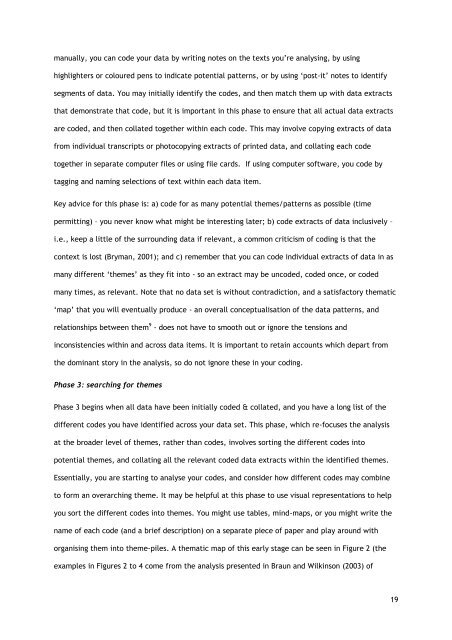Braun, V. and Clarke, V. - UWE Research Repository - University of ...
Braun, V. and Clarke, V. - UWE Research Repository - University of ...
Braun, V. and Clarke, V. - UWE Research Repository - University of ...
Create successful ePaper yourself
Turn your PDF publications into a flip-book with our unique Google optimized e-Paper software.
manually, you can code your data by writing notes on the texts you‟re analysing, by using<br />
highlighters or coloured pens to indicate potential patterns, or by using „post-it‟ notes to identify<br />
segments <strong>of</strong> data. You may initially identify the codes, <strong>and</strong> then match them up with data extracts<br />
that demonstrate that code, but it is important in this phase to ensure that all actual data extracts<br />
are coded, <strong>and</strong> then collated together within each code. This may involve copying extracts <strong>of</strong> data<br />
from individual transcripts or photocopying extracts <strong>of</strong> printed data, <strong>and</strong> collating each code<br />
together in separate computer files or using file cards. If using computer s<strong>of</strong>tware, you code by<br />
tagging <strong>and</strong> naming selections <strong>of</strong> text within each data item.<br />
Key advice for this phase is: a) code for as many potential themes/patterns as possible (time<br />
permitting) – you never know what might be interesting later; b) code extracts <strong>of</strong> data inclusively –<br />
i.e., keep a little <strong>of</strong> the surrounding data if relevant, a common criticism <strong>of</strong> coding is that the<br />
context is lost (Bryman, 2001); <strong>and</strong> c) remember that you can code individual extracts <strong>of</strong> data in as<br />
many different „themes‟ as they fit into - so an extract may be uncoded, coded once, or coded<br />
many times, as relevant. Note that no data set is without contradiction, <strong>and</strong> a satisfactory thematic<br />
„map‟ that you will eventually produce - an overall conceptualisation <strong>of</strong> the data patterns, <strong>and</strong><br />
relationships between them 9 - does not have to smooth out or ignore the tensions <strong>and</strong><br />
inconsistencies within <strong>and</strong> across data items. It is important to retain accounts which depart from<br />
the dominant story in the analysis, so do not ignore these in your coding.<br />
Phase 3: searching for themes<br />
Phase 3 begins when all data have been initially coded & collated, <strong>and</strong> you have a long list <strong>of</strong> the<br />
different codes you have identified across your data set. This phase, which re-focuses the analysis<br />
at the broader level <strong>of</strong> themes, rather than codes, involves sorting the different codes into<br />
potential themes, <strong>and</strong> collating all the relevant coded data extracts within the identified themes.<br />
Essentially, you are starting to analyse your codes, <strong>and</strong> consider how different codes may combine<br />
to form an overarching theme. It may be helpful at this phase to use visual representations to help<br />
you sort the different codes into themes. You might use tables, mind-maps, or you might write the<br />
name <strong>of</strong> each code (<strong>and</strong> a brief description) on a separate piece <strong>of</strong> paper <strong>and</strong> play around with<br />
organising them into theme-piles. A thematic map <strong>of</strong> this early stage can be seen in Figure 2 (the<br />
examples in Figures 2 to 4 come from the analysis presented in <strong>Braun</strong> <strong>and</strong> Wilkinson (2003) <strong>of</strong><br />
19

















